Press, press, do a fly, press, and then press again.
This is usually the pattern most chest exercise enthusiasts follow. However, to build a strong and defined chest you need to engage your lower pecs more, which is something many people seem to neglect.
While seeing results might take some time, the most important thing is to find the right exercise program for you. This is integral to optimize the benefits you receive – such muscle growth and strength increase.
The ten lower chest exercises we’ll share with you today are: decline dumbbell bench press, dumbbell chest fly, chest dip, cable crossover, standard push-up, incline push-up, decline push-up, medicine push-up, seated machine fly, and jackhammer pushdown.
We’ll go through each exercise, cover the benefits of lower chest workouts, and then share some useful tips on how to get the best results from your training.
What are the Best Lower Chest Exercises?
Here are the most effective exercises to work your lower chest:
- Decline Dumbbell Bench Press: 2 to 4 sets of 8 to 12 repetitions
- Dumbbell Chest Fly: 2 to 4 sets of 10 to 15 repetitions
- Chest Dip: 2 to 4 sets of 8 to 12 repetitions
- Cable Crossover: 2 to 4 sets of 10 to 15 repetitions
- Push-up: 2 to 4 sets of as many reps as it takes to get within 1 to 2 reps short of failure
- Incline push-up: 2 to 4 sets of as many reps as it takes to get within 1 to 2 reps short of failure
- Decline push-up: 2 to 4 sets of as many reps as it takes to get within 1 to 2 reps short of failure
- Medicine Ball Push-up: 2 to 4 sets of as many reps as it takes to get within 1 to 2 reps short of failure
- Seated Machine Fly: 2 to 4 sets of 10 to 15 repetitions
- Jackhammer Pushdown: 2 to 4 sets of 10 to 15 repetitions
To train your lower chest, you need to do exercises that require the lower portion of the pectoralis major to create muscular force.
In general, these exercises are similar to other chest exercises. It’s difficult to isolate the lower chest specifically, as the abdominal and sternocostal heads of the pectoralis major are still part of the same, larger muscle. Still, some research has shown that changing the angle used during pressing exercises — by using a decline bench, for example — increases muscle excitation in the lower chest. [1] Increasing the attentional focus on the particular aspect of the muscle you’re trying to work may also increase muscular excitation. [2] Finally, using relatively challenging weights that result in getting close to or near failure may also help. [3]
For nearly all pressing variations, the pectoralis major, anterior deltoid, and triceps brachii are the main muscles being targeted. Changing the angle or manner by which these muscles must overcome the resistance can change muscular excitation levels. For example, an incline bench tends to increase muscle excitation in the anterior deltoid and upper portion of the pec major, whereas doing dumbbell flyes also requires some contribution from the biceps brachii. [4, 5]
That all being said, it’s not clear whether changing muscular excitation levels, a measure of electrical activity in the muscle being studied, alters the amount of muscle growth or strength resulting from exercise. Scientific evidence suggests that electrical differences are not really predictive of actual outcomes, such as differences in muscle size and strength when using one or more variation(s) over the other. [6]
1. Decline Dumbbell Bench Press
The decline bench press is a variation of the bench press where the bench being used is angled downwards relative to the floor about 15 to 30 degrees. Like other pressing exercises, the decline dumbbell bench press works the triceps and anterior deltoid, and may provide more training stimulus to the lower region of the pectoralis major.
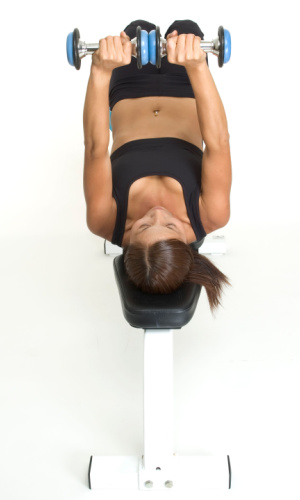
Movement Category: Secondary
Programming 2 to 4 sets of 8 to 12 repetitions.
Weight: Use a weight that leaves you 2 to 3 reps short of failure, e.g. RPE 7 to 8.
Decline Dumbbell Bench Press Instructions
- Get the dumbbells off the ground with a neutral grip and your hands facing in. Place the dumbbells’ ends in your hip crease and sit on the edge of the decline bench.
- To get started, lay down and place the weights near your chest. Once you’re ready, take a deep breath and press the dumbbells to lockout at the top.
- Gradually lower the dumbbells while keeping as much control as you can – the handles ought to be positioned approximately at the same level as the chest.
- Bring the dumbbells back to the initial position while tightening the chest.
Pro Tip:
In order to maintain the elbows in a neutral position, position the weights at a 45-degree angle.
2. Dumbbell Chest Flyes
Dumbbell flyes are considered a single-joint exercise for the chest. Unlike multi-joint exercises like barbell and dumbbell bench presses that involve movements of the shoulder and elbow joints, dumbbell flyes focus on movement of the shoulder and minimal movement of the elbow.
In general, multi-joint exercises use more muscle groups and heavier weights than single-joint isolation exercises. These features of isolation exercises tend to allow an individual to target specific muscles more readily, with less fatigue being generated from training. [7] Together, this makes isolation exercises like dumbbell flyes a great movement to include when muscle size is the goal.
From a muscle targeting standpoint, data measuring muscle excitation (EMG) shows that dumbbell flyes rely heavily on the pectoralis major, biceps brachii, and anterior deltoid. Compared to the bench press, dumbbell flyes use relatively little triceps brachii to complete the exercise. [8]
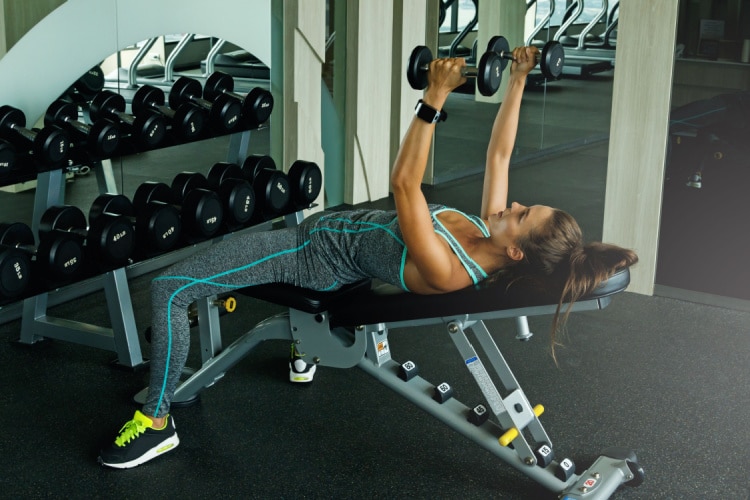
If increasing the size of your chest is the goal, we recommend that you include the dumbbell fly as part of your chest workout, regardless of whether you’re a beginner or a more advanced lifter. To do the exercise, you’ll need dumbbells and a bench.
Movement Category: Tertiary
Programming 2 to 4 sets of 10 to 15 repetitions.
Weight: Use a weight that leaves you 1 to 2 reps short of failure, e.g. RPE 8 to 9.
Dumbbell Chest Fly Instructions
- Lift the dumbbells off the ground with a neutral grip and your hands facing in. Place the dumbbells’ ends in your hip crease and sit on the edge of the decline bench.
- To get ready, lie down and place the weights near your chest. Take a deep breath and press the dumbbells to lockout at the top.
- Slowly contract your shoulder blades, unlock your elbows, and drop the dumbbells laterally while preserving the same position at your elbows.
- When the dumbbells touch your chest, reverse the movement by pressing your pecs together and taking the dumbbells to their initial position.
Pro Tip:
To maintain continuous tension in the targeted muscles, don’t bang the dumbbells together at the end of every repetition. Rather, maintain control throughout the movement.
3. Chest Dip
Often called parallel-bar dip, straight-bar dip, or just a dip, the chest dip is a great exercise to target not only the lower region of your pecs but also your shoulders and triceps. While many exercises work the lower chest, this one uses a vertical pressing movement pattern, which allows for a unique stimulation of the pecs. [9]
To make it more challenging or target different muscle areas, you can add belts, chains, and weighted vests to the chest dip. However, we recommend first mastering the standard version of the exercise before adding equipment.
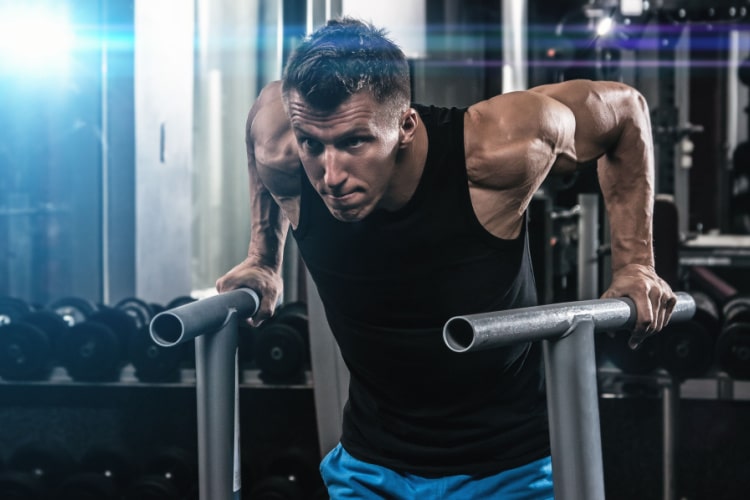
Movement Category: Secondary
Programming 2 to 4 sets of 8 to 12 repetitions.
Weight: Use a weight that leaves you 2 to 3 reps short of failure, e.g. RPE 7 to 8.
Chest Dip Instructions
- Grab both handles of the dip bar station and push yourself upward by extending your arms to lift your feet off the floor. Your arms are straight and supporting your body weight.
- Without flexing your elbows, squeeze your shoulder blades together.
- Tilt forward, bend your knees, and cross at your ankles for improved stability.
- Lower your body while bending the elbows outward. They should flare around six to eight inches from your sides, until both arms reach a 90-degree angle.
- Refrain from rolling your shoulders forward or letting your shoulder blades move upward or apart.
- Press up to straighten your arms and go back to the initial position.
Pro Tip:
Depending on which muscles you want to target, there are two ways to do a chest dip. if you want to boost triceps engagement, then stay upright and have your elbows in close proximity; if you want to intensify chest engagement, lean forward.
4. Cable Crossover
The cable crossover is an isolation exercise that utilizes a cable machine to work the pecs. What’s especially great about cable crossovers is their versatility to target different areas of the chest simply by adjusting the cable height. To work your lower chest muscles, the handles are placed in a high position, typically above your head.
While it targets the pecs, this exercise also works out your anterior deltoid and biceps brachii muscles. If you’re looking for something more dynamic and don’t quite enjoy laying on a bench or pressing dumbbells, the cable crossover should be your go-to.
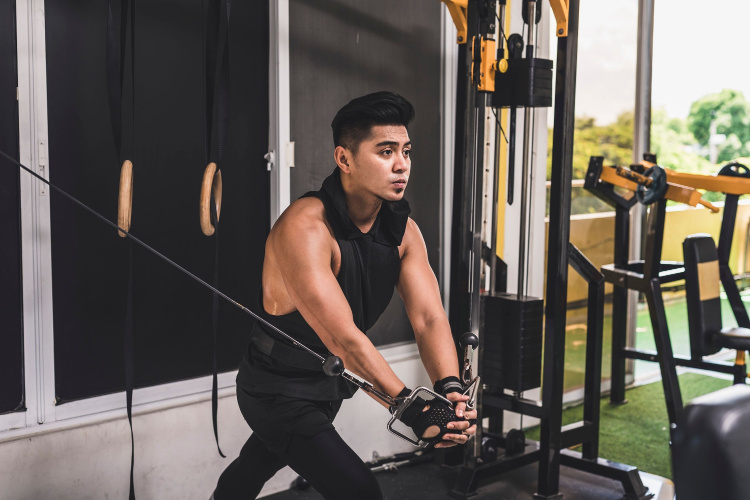
Movement Category: Tertiary
Programming 2 to 4 sets of 10 to 15 repetitions.
Weight: Use a weight that leaves you 1 to 2 reps short of failure, e.g. RPE 8 to 9.
Cable Crossover Instructions
- Stand in front of the machine and grasp the handles with your hands. Take a step forward so the weights in the cable machine gradually start moving out of the stack. You’ll feel the pressure of the weights in your hands. Keep going until the cables are stretched.
- Keep your back straight throughout the exercise. Place one foot in front of the other with your knee bent to assist you in keeping balance while doing the movement. This is your starting position.
- Next, pull your hands in an arch motion in front of the body. If you placed the hands in a high position, as we suggested, pull them down now.
- Get your hands to almost touch each other as you squeeze your chest muscles.
- Gradually lift your arms back to the starting position.
Pro Tip:
Don’t swing the weights too fast — this isn’t a speed competition. A slower and more controlled approach will keep you safe from injury, optimize the benefits, and aid you in growing stronger over time.
5. Push-up
As closed kinetic chain exercises (exercises where the hand and/or foot are fixed in space and can’t move), push-ups target the chest, arms, shoulders, and core muscles. Such exercises require fixing the terminal segment or providing it with considerable resistance so that it cannot move, like the hands pushing against the ground during push-ups. [10]
This exercise can be modified based on your fitness level — beginners can stick to standard push-ups, whereas more advanced trainees can try more challenging variations, such as the decline push-ups (more about those in a minute).
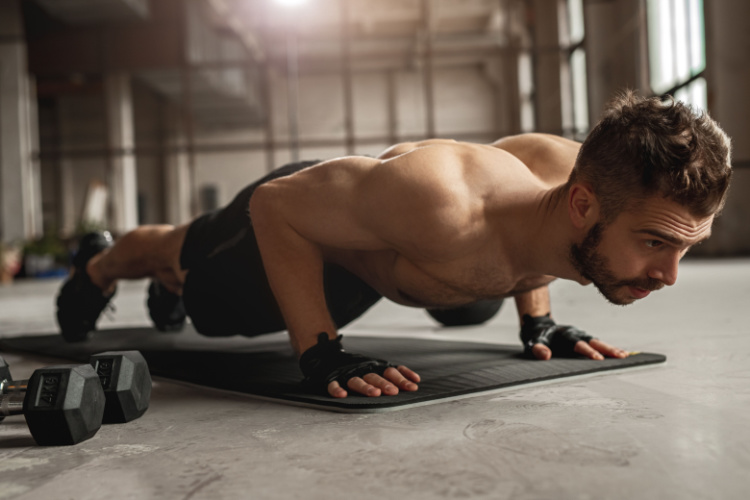
Movement Category: Tertiary
Programming: 2 to 4 sets of as many reps as it takes to get within 1 to 2 reps short of failure, e.g. RPE 8 to 9.
Weight: Bodyweight
Push-up Instructions
- Get on the ground on all fours. Place your hands a bit wider than the shoulders without locking out your elbows. Straighten out your legs into plank position.
- Ensure your core is tight during the entire exercise. Also, keep your body straight without arching your back or sagging in the middle.
- Once you’re in position, tighten your abs.
- Take a deep breath and lower your body towards the ground, until the elbows bend to a 90-degree angle.
- Exhale as you contract the chest and push into your palms to go back to your initial position.
Pro Tip:
Keep your spine straight during the exercise, and try not to lift your seat up. It’s useful to think of a push-up as a “moving plank.”
6. Incline Push-up
A great alternative if you struggle to do a standard push-up, the incline push-up targets the chest muscles while also engaging your shoulders, triceps, and other ab, back, leg, and hip muscles. You can do incline push-ups wherever you are — you just need an elevated, stable surface like a wall, bench, or table. What makes incline push-ups so great is that they’re highly scalable — you can make it as easy or as difficult as you like by increasing or decreasing the height of the surface.
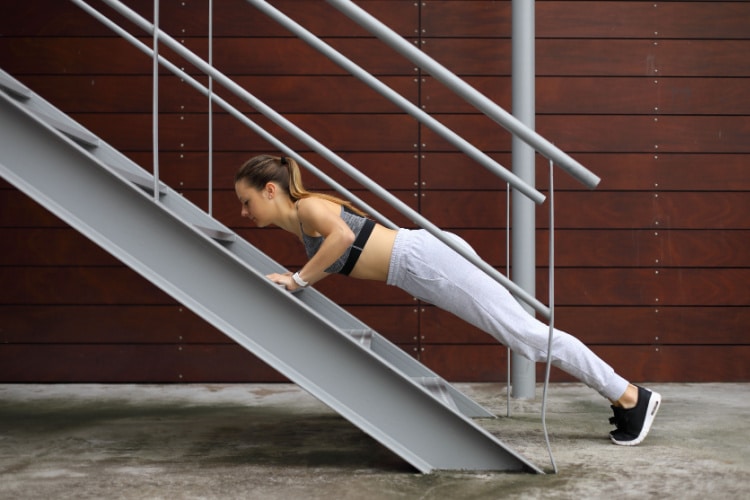
Movement Category: Tertiary
Programming: 2 to 4 sets of as many reps as it takes to get within 1 to 2 reps short of failure, e.g. RPE 8 to 9.
Weight: Bodyweight
Incline Push-up Instructions
- Stand facing the elevated surface (usually a table or a bench).
- Place both hands on the edge of the surface, a bit wider than shoulder-width apart.
- Keep the arms straight and don’t lock the elbows.
- Take a deep breath and bend your elbows parallel to your body to gradually lower the chest until you touch the edge of the surface. Ensure that your body remains straight and tight during the movement.
- Push your body away from the surface until the elbows are extended, but without locking them out at the top. Exhale.
Pro Tip:
Feel free to experiment with your grip width. Start with your hands a bit wider than shoulder-width apart, as we suggested above, and see how that feels. A wide grip width makes push-up easier to execute but puts more strain on the shoulders. As you build muscle, you can begin to narrow your grip width for better results.
7. Decline Push-up
The decline push-up tends to be harder than the regular push-up as the individual is forced to lift a greater percentage of their body weight. For example, when tested, a regular push-up requires an individual to lift ~64% of their body weight, whereas a kneeling push-up uses ~49%. [11]
Bench push-ups target the chest muscles, shoulders, arms, and back. To do this exercise, you need a bench or another sturdy, elevated surface that you can put your feet on.
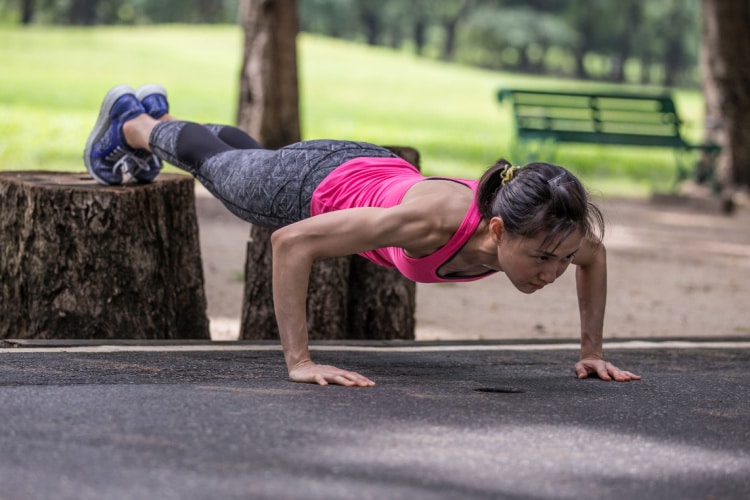
Movement Category: Tertiary
Programming: 2 to 4 sets of as many reps as it takes to get within 1 to 2 reps short of failure, e.g. RPE 8 to 9.
Weight: Bodyweight
Decline Push-up Instructions
- Start on your hands and knees. Ensure your hands are about shoulder-width or a little wider apart. Don’t place your hands too far apart, as you’ll limit your mobility during the descent.
- Get into position by extending the legs and placing both feet, i.e. toes, on the bench (or your chosen surface).
- Keep your body straight, and avoid any potential sagging in the hips.
- Bend your elbows to lower your body until it almost reaches the ground. We recommend stopping when your elbows are at the same level as the ribcage. As you descend, look ahead on the floor.
- Push into the floor and straighten out your elbows without locking them to return to the initial position.
Pro Tip:
Adjust the decline push-up based on your fitness level and goals by modifying the bench height. In essence, the higher the surface, the more challenging the exercise. If you’re a newbie, we suggest beginning with a lower surface; if you’re more advanced, feel free to increase the height.
8. Medicine Ball Push-up
Exercising with a ball can help you advance your training, as the instability of the ball makes for a more challenging workout. However, if you’re mindful of your moves and maintain control at all times, you should be fine.
The medicine ball push-up is an advanced push-up variation performed with a medicine ball or a stability ball. The purpose of including the ball is to create a wider range of motion than a standard push-up, hence, boosting the contribution of your pecs, delts, and core muscles.

Movement Category: Tertiary
Programming: 2 to 4 sets of as many reps as it takes to get within 1 to 2 reps short of failure, e.g. RPE 8 to 9.
Weight: Bodyweight
Ball Push-up Instructions
- Kneel on the floor and bring both feet together behind you. Slowly bend forward and place both palms on the sides of the medicine ball. Shift your weight forward until your shoulders are directly positioned over your hands and the ball. Readjust your feet if needed for full extension of your body without any sagging. Tighten your torso by contracting your core and abs.
- Begin to slowly lower your body toward the ball bit by bit. Keep your torso rigid at all times. Contract your glutes and thighs for better balance. Descend until the chest almost touches the ball. Keep your elbows close to your body.
- Next, press into the palms and straighten the arms to push yourself back to the starting position.
Pro Tip:
Make sure you do an equal number of reps with each hand on the ball.
9. Seated Machine Flyes
The seated machine fly, also known as the pec-deck fly, is a great exercise if you’re looking to increase chest strength and muscle mass in your pecs. The chest is the primary muscle being targeted. The anterior deltoid aids in the movement so it gets to do some work, as well.
Compared to chest flyes with dumbbells, seated machine flyes have a slightly different force curve based on the cams and pulleys used in the machine, which requires the muscles to overcome the resistance in a slightly different manner. In addition, using the machine fixes the path of the arc, which may produce a different stimulus compared to dumbbell flyes.
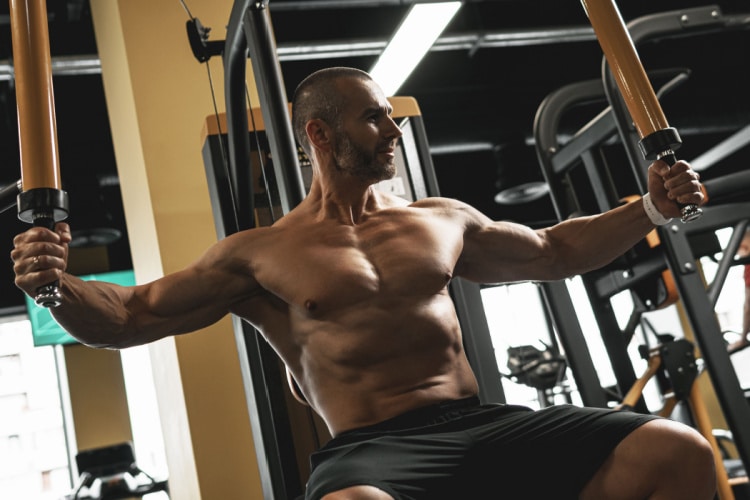
Movement Category: Tertiary
Programming 2 to 4 sets of 10 to 15 repetitions.
Weight: Use a weight that leaves you 1 to 2 reps short of failure, e.g. RPE 8 to 9.
Seated Machine Flyes Instructions
- Adjust the seat pad by lifting it or lowering it depending on your height (the handles should be the same level as your chest).
- Place your feet on the ground.
- Extend your arms on each side and grab the handles. Keep the wrists and elbows at the same level as your shoulders.
- Gradually, press your arms towards one another. Ensure your wrists are somewhat relaxed and keep a soft bend in your elbows.
- Once your arms are connected in front of your chest, stop for a second.
- Afterward, start bringing your arms back to the initial position by opening the chest. Keep your back straight at all times.
Pro Tip:
A slow and controlled exercise tempo will help you achieve maximal results.
10. Jackhammer Pushdown
The jackhammer pushdown provides one of the best possible angles to isolate your lower chest and reduce the participation of your triceps, which makes it a great power chest exercise. Apart from your chest muscles, the jackhammer pushdown also activates traps, lats, obliques, and abs.
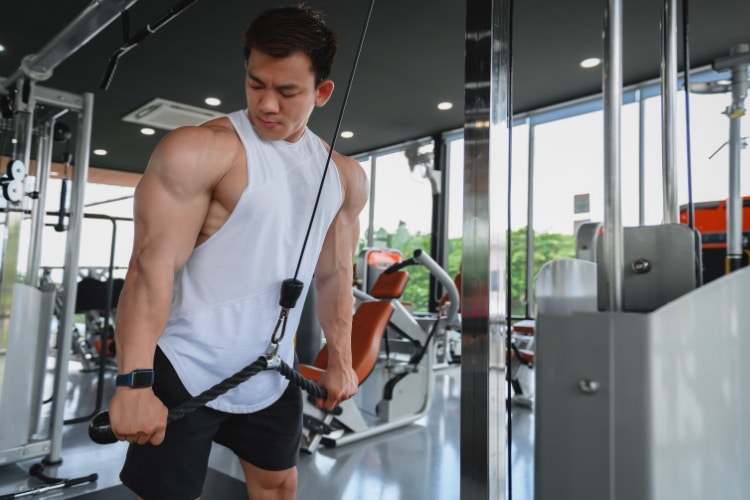
Movement Category: Tertiary
Programming 2 to 4 sets of 10 to 15 repetitions.
Weight: Use a weight that leaves you 1 to 2 reps short of failure, e.g. RPE 8 to 9.
Jackhammer Pushdown Instructions
- Attach the short straight bar handle onto the cable pulley as though you’re doing a standard triceps pushdown.
- Stand facing the machine, approximately a foot’s distance away.
- Hinge forward slightly at the hips to tilt your torso in the direction of the cable while maintaining a firmly planted and vertical posture with your legs.
- With your elbows spread wide to the sides and your palms facing down, take the handle with an overhand grip (this elbow position is what differentiates the exercise from the regular triceps pushdown).
- As you push and extend your elbows, bring them inward.
- As soon as your elbows are completely locked out, at the bottom of the hold, pause.
- Slowly go back to your beginning position — resist the fall of the weight stack on the cable as you let your elbows flare out.
Pro Tip:
To visualize the movement more easily, think of it as a motion resembling a close-grip bench press, but with your arms flared out on purpose.
Why Should You Train the Different Sections of the Chest?
The chest is part of a bigger group of so-called pushing muscles located in your upper body. The chest itself is made up of the pectoralis major, pectoralis minor, and the serratus anterior. Developing these muscles will help you perform daily tasks, like lifting your child, as well as improved gym performance, like doing a barbell bench press.
To better develop the entirety of your chest area, you’ll need to hit it with relatively heavy weights and carefully-picked exercises. While not everyone will need to train the lower chest directly, some may benefit or prefer to do so to increase size in this area based on their own preferences and response to training.
Training for Muscle Hypertrophy
The way to increase muscle mass is through lifting weights through a relatively large range of motion using a load that gets the lifter to or within a few repetitions of muscular failure. [12] The way it works is, when muscle protein synthesis outpaces muscle protein breakdown over an extended length of time, the size of the muscle fiber increases. Although it might seem that muscle damage is necessary for muscle growth, hypertrophy doesn’t seem to happen until muscle protein synthesis becomes more prevalent and muscle protein breakdown is reduced. [13,14] Put simply, hypertrophy is delayed until the person adjusts to it.
To achieve muscular hypertrophy, pay attention to your training volume — the higher the training volume, the greater the hypertrophy, as long as the trainee can endure it. [15,16] If you opt for isolation exercises, you can target specific muscles (such as your lowest chest in this case), which is more than likely going to boost hypertrophy as opposed to opting for compound lifts that may or may not adequately load the muscle. [17,18]
Starting a great hypertrophy program typically uses a higher training volume compared to strength programs. Also, personalization is key to ensuring you get the training stress you can endure and enjoy optimal results.
What are the Benefits of Lower Chest Exercises?
Apart from growing your strength and your chest muscles, there are many other benefits of working on your lower-chest muscles including.
Improved Respiratory Capacity in Specific Cases
There are some cases where chest exercises can improve respiratory function. For instance, upper body resistance training can bring about significant changes in the pulmonary function in male sedentary smokers. [19]
What’s more, people suffering from COPD (Chronic Obstructive Pulmonary Disease) experience a wide range of issues linked to muscular dysfunction, overall quality of life, and functional capacity, to name a few. Resistance training has proven to be highly beneficial in these patients. According to some studies, such training is said to boost muscle strength and hypertrophy, improve muscle endurance and quality of life, and lessen the markers of systemic inflammation. [20]
Stronger Athletic Performance
Stronger pecs improve athletic performance. Whether you’re into tennis, basketball, or volleyball, simply hitting the gym, rest assured you’ll achieve better results when you commit to your chest workout.
For instance, there’s research that suggests that upper body strength is linked with higher club head speed with golfers and with a higher punching velocity in boxers [21,22]
Improved Bone Density
Engaging in exercises such as these can improve bone density and reduce the risk of bone diseases such as osteoporosis. For instance, the chest fly machine is said to help boost body mass and bone density. [23]
Versatility
You can find options for trainees of all fitness levels on our list of lower chest exercises.
- Best for beginners: incline push-ups and regular push-ups;
- Best for intermediate: decline push-ups;
- Best for advanced: medicine ball push-ups.
These are just general guidelines, though. You can modify almost every exercise to make it more easy or challenging. For instance, adjusting the angle on a decline push-up or playing with the hand width of a standard push-up will affect its difficulty level.
Better Cardiovascular Health
Performing chest exercises can improve your cardiovascular health. Namely, a 2019 study found that men who can do 40 push-ups have fewer cardiovascular diseases compared to men who can’t do even 10 push-ups. [24]
What’s more, lifting weights is linked with reduced risk of many health-related issues such as cardiovascular diseases, cancer, and type II diabetes. [25] Physical activity, in general, is said to have beneficial effects on various health outcomes, including cardiovascular disease. [26]
Burn (Slightly) More Calories
The more you engage in strength training exercises, the more calories you end up burning. According to the CDC (Centers for Disease Control and Prevention), the average amount of calories burned during strength training exercises such as push-ups is around seven calories per minute. [27]
With that said, take this as a general estimate, and not something set in stone, as how many calories you may burn during a workout session depends on many factors such as height, weight, gender, age, your workout intensity, and frequency.
How Caloric Expenditure Works
About 40% of an adult’s body weight is made up of skeletal muscle mass, which accounts for 80% of a person’s resting metabolic rate. [28, 29] Some people think that training the chest will increase someone’s resting metabolic rate because the muscles in the chest are relatively large in comparison to some other muscles. A person’s total daily energy expenditure would presumably increase with an increase in resting metabolic rate, but scientific evidence suggests that this is probably not happening to a significant degree.
One kilogram of muscle is said to use approximately 13 calories per day, while one kilogram of fat uses 4.5 calories per day. [30] A person would need to put on a lot of muscle mass in order to significantly alter their daily energy expenditure. For instance, it usually takes years to gain 10 kg of muscle, and doing so would result in an increase in daily energy expenditure of about 85 calories.
Nevertheless, the mechanisms fundamental to weightlifting are far more intricate, involving modifications to the brain, endocrine system, muscles, and more.
Tips for Effective Lower Chest Exercises
The best way to avoid getting frustrated with your lower chest workout routine is to have a plan in place and adjust it over time based on your results. Here are several tips on how to work out the lower chest so you can optimize:
- Start off slowly and build your way off mindfully. This applies to choosing the right exercises, number of sets and reps, and weight, among others. Exercise selection is mostly up to personal preference and available equipment, however we recommend using a combination of compound (multi-joint) and isolation (single-joint) exercises to train the chest.
- Tailor the volume to your individual needs. Volume is the total amount of sets and reps performed for a given muscle or muscle group in a period of time, e.g. a session or over a week. While higher volume programs tend to produce greater muscle growth in general, the amount of volume that is appropriate for a given individual depends on their current fitness levels and the rest of the training program. We recommend starting with around 10 to 15 sets per week for training the chest and seeing how you respond after a few weeks. Adding too much volume too quickly can outstrip your ability to recover and adapt to training. This could result in too much fatigue being generated from the training, thereby limiting muscle growth as the individual doesn’t have any resources left over to generate more muscle tissue because all of it is used to keep up with training. Worse yet, increasing training stress from too much volume could lead to overuse injury.
- Begin with a manageable weight. Note that in our recommendations for loading, we use Rate of Perceived Exertion (RPE) to communicate how “hard” the effort should be for each set. This allows you the lifter to determine the correct weight for the day and adjust it as you get stronger over time. On days when your performance is a bit lower for whatever reason, it’s advisable to reduce the load in order to match the prescribed effort level and control fatigue. By matching the weight to your current level of fitness each training day, we can progressively load the muscles to get the best results.
- Adjust the program over time. It’s important to note that people will respond differently to the same training. Some will thrive and grow like a weed on the most basic of programs, whereas others will have to be more calculated and intentional with their program design and progressive loading. While many concepts in exercise programming are good rules of thumb, tailoring the program to the individual is necessary to achieve the best results.
Conclusion
Hopefully, you found an exercise or two on our list for your upper-body workout day, regardless of your fitness level. Add any of these lower chest exercises to your programming and watch your strength, muscles, bone density, and heart health improve.
If you’re looking for training beyond the lower chest, consider trying out our more extensive templates that work the entire body. Our team of health and fitness professionals can also work with you individually and prepare a custom training program. Our methods are backed by the most up-to-date research in sports medicine, so you’ll never have to worry about snake oil salesmen here.
References:
1. Saeterbakken, Atle Hole et al. “The Effects of Bench Press Variations in Competitive Athletes on Muscle Activity and Performance.” Journal of human kinetics vol. 57 61-71. 22 Jun. 2017, doi:10.1515/hukin-2017-0047
2. Snyder, Benjamin J, and Wesley R Fry. “Effect of verbal instruction on muscle activity during the bench press exercise.” Journal of strength and conditioning research vol. 26,9 (2012): 2394-400. doi:10.1519/JSC.0b013e31823f8d11
3. Stastny, Petr et al. “A systematic review of surface electromyography analyses of the bench press movement task.” PloS one vol. 12,2 e0171632. 7 Feb. 2017, doi:10.1371/journal.pone.0171632
4. Rodríguez-Ridao, David et al. “Effect of Five Bench Inclinations on the Electromyographic Activity of the Pectoralis Major, Anterior Deltoid, and Triceps Brachii during the Bench Press Exercise.” International journal of environmental research and public health vol. 17,19 7339. 8 Oct. 2020, doi:10.3390/ijerph17197339
5. Solstad, Tom Erik et al. “A Comparison of Muscle Activation between Barbell Bench Press and Dumbbell Flyes in Resistance-Trained Males.” Journal of sports science & medicine vol. 19,4 645-651. 19 Nov. 2020
6. Vigotsky, Andrew D et al. “Greater electromyographic responses do not imply greater motor unit recruitment and ‘hypertrophic potential’ cannot be inferred.” Journal of strength and conditioning research vol. 31,1 (2017): e1-e4. doi:10.1519/JSC.0000000000001249
7. Gentil, Paulo et al. “A Review of the Acute Effects and Long-Term Adaptations of Single- and Multi-Joint Exercises during Resistance Training.” Sports medicine (Auckland, N.Z.) vol. 47,5 (2017): 843-855. doi:10.1007/s40279-016-0627-5
8. Solstad, Tom Erik et al. “A Comparison of Muscle Activation between Barbell Bench Press and Dumbbell Flyes in Resistance-Trained Males.” Journal of sports science & medicine vol. 19,4 645-651. 19 Nov. 2020
9. Baz-Valle, E., Schoenfeld, B. J., Torres-Unda, J., Santos-Concejero, J., & Balsalobre-Fernández, C. (2019). The effects of exercise variation in muscle thickness, maximal strength and motivation in resistance trained men. PLOS ONE, 14(12), e0226989. https://doi.org/10.1371/journal.pone.0226989
10. Prokopy, M. P., Ingersoll, C. D., Nordenschild, E., Katch, F. I., Gaesser, G. A., & Weltman, A. (2008). Closed-Kinetic Chain Upper-Body Training Improves Throwing Performance of NCAA Division I Softball Players. Journal of Strength and Conditioning Research, 22(6), 1790–1798. https://doi.org/10.1519/jsc.0b013e318185f637
11. Suprak, David N et al. “The effect of position on the percentage of body mass supported during traditional and modified push-up variants.” Journal of strength and conditioning research vol. 25,2 (2011): 497-503. doi:10.1519/JSC.0b013e3181bde2cf
12. MacDougall, J D et al. “Muscle fiber number in biceps brachii in bodybuilders and control subjects.” Journal of applied physiology: respiratory, environmental and exercise physiology vol. 57,5 (1984): 1399-403. doi:10.1152/jappl.1984.57.5.1399
13. Biressi S, Molinaro M, Cossu G. Cellular heterogeneity during vertebrate skeletal muscle development. Dev Biol. 2007 Aug 15;308(2):281-93. doi: 10.1016/j.ydbio.2007.06.006. Epub 2007 Jun 13. PMID: 17612520.
14. Damas F, Libardi CA, Ugrinowitsch C. The development of skeletal muscle hypertrophy through resistance training: the role of muscle damage and muscle protein synthesis. Eur J Appl Physiol. 2018 Mar;118(3):485-500. doi: 10.1007/s00421-017-3792-9. Epub 2017 Dec 27. PMID: 29282529.
15.Schoenfeld, Brad J et al. “Resistance Training Volume Enhances Muscle Hypertrophy but Not Strength in Trained Men.” Medicine and science in sports and exercise vol. 51,1 (2019): 94-103. doi:10.1249/MSS.0000000000001764
16. Figueiredo, Vandré Casagrande et al. “Volume for Muscle Hypertrophy and Health Outcomes: The Most Effective Variable in Resistance Training.” Sports medicine (Auckland, N.Z.) vol. 48,3 (2018): 499-505. doi:10.1007/s40279-017-0793-0
17. Ema, Ryoichi et al. “Inhomogeneous architectural changes of the quadriceps femoris induced by resistance training.” European journal of applied physiology vol. 113,11 (2013): 2691-703. doi:10.1007/s00421-013-2700-1
18. Earp, Jacob E et al. “Inhomogeneous Quadriceps Femoris Hypertrophy in Response to Strength and Power Training.” Medicine and science in sports and exercise vol. 47,11 (2015): 2389-97. doi:10.1249/MSS.0000000000000669
19.Singh, V P et al. “Effects of upper body resistance training on pulmonary functions in sedentary male smokers.” Lung India : official organ of Indian Chest Society vol. 28,3 (2011): 169-73. doi:10.4103/0970-2113.83971
20. Vonbank, Karin et al. “Strength training increases maximum working capacity in patients with COPD–randomized clinical trial comparing three training modalities.” Respiratory medicine vol. 106,4 (2012): 557-63. doi:10.1016/j.rmed.2011.11.005
21. López-Laval, Isaac et al. “Relationship Between Bench Press Strength and Punch Performance in Male Professional Boxers.” Journal of strength and conditioning research vol. 34,2 (2020): 308-312. doi:10.1519/JSC.0000000000003362
22. Sorbie, Graeme G.; Glen, Jonathan; Richardson, Ashley K.. Positive Relationships Between Golf Performance Variables and Upper Body Power Capabilities. Journal of Strength and Conditioning Research 35():p S97-S102, December 2021. | DOI: 10.1519/JSC.0000000000003788
23. Thomas, M. H., & Burns, S. P. (2016). Increasing Lean Mass and Strength: A Comparison of High Frequency Strength Training to Lower Frequency Strength Training. International Journal of Exercise Science, 9(2), 159–167. https://www.ncbi.nlm.nih.gov/pmc/articles/PMC4836564/
24. 5. Yang, J., Christophi, C. A., Farioli, A., Baur, D. M., Moffatt, S., Zollinger, T. W., & Kales, S. N. (2019). Association Between Push-up Exercise Capacity and Future Cardiovascular Events Among Active Adult Men. JAMA Network Open, 2(2), e188341. https://doi.org/10.1001/jamanetworkopen.2018.8341
25. Vann, Christopher G et al. “Skeletal Muscle Myofibrillar Protein Abundance Is Higher in Resistance-Trained Men, and Aging in the Absence of Training May Have an Opposite Effect.” Sports (Basel, Switzerland) vol. 8,1 7. 10 Jan. 2020, doi:10.3390/sports8010007
26. Kodama S, Saito K, Tanaka S, et al. Cardiorespiratory fitness as a quantitative predictor of all-cause mortality and cardiovascular events in healthy men and women: a meta-analysis. JAMA 2009; 301:2024.
27. CDC. (2003). General Physical Activities Defined by Level of Intensity. https://www.cdc.gov/nccdphp/dnpa/physical/pdf/PA_Intensity_table_2_1.pdf
28. Frontera, Walter R, and Julien Ochala. “Skeletal muscle: a brief review of structure and function.” Calcified tissue international vol. 96,3 (2015): 183-95. doi:10.1007/s00223-014-9915-y
29. Yu, Solomon et al. “Lean body mass: the development and validation of prediction equations in healthy adults.” BMC pharmacology & toxicology vol. 14 53. 14 Oct. 2013, doi:10.1186/2050-6511-14-53
30. Wang, Zimian et al. “Evaluation of specific metabolic rates of major organs and tissues: comparison between men and women.” American journal of human biology : the official journal of the Human Biology Council vol. 23,3 (2011): 333-8. doi:10.1002/ajhb.21137